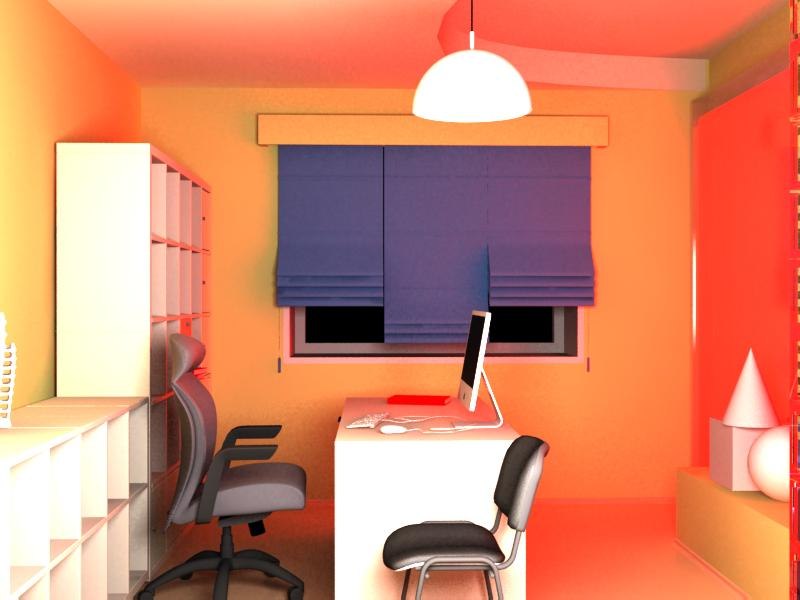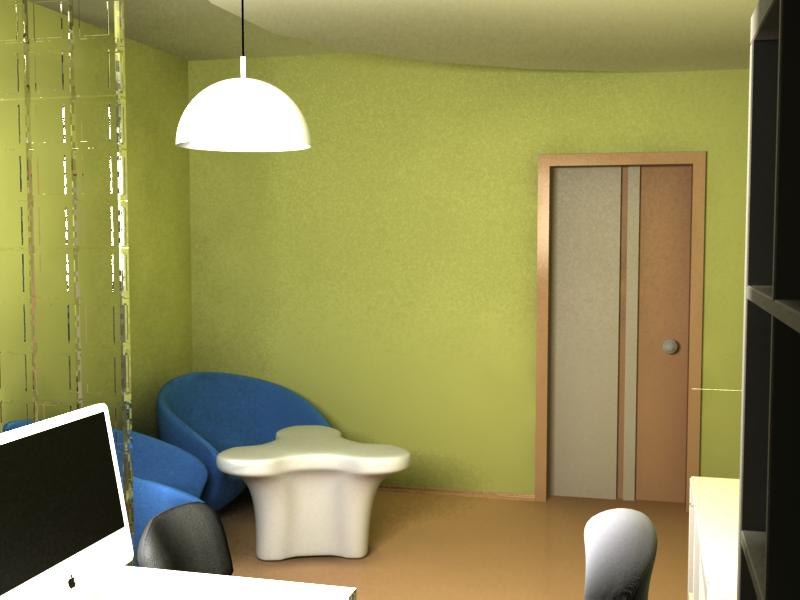Color as a factor in labor efficiency
Introductory
I have always believed that color affects the human perception of the world around him. But it is important to understand that color affects us 24 hours a day and 7 days a week, and not only through the organs of sight.Today, the problem of improving the efficiency of labor is one of the key. Here techniques or technologies acquired by man in the process of his development, which are applicable in the modern world, can come to the rescue. Scientists are currently developing technologies, including those based on ancient techniques that help increase the efficiency of labor for commercial purposes. In order for a company employee to fulfill his or her duties in a quality manner, and therefore there was a return as an increase in efficiency, it is necessary that they be healthy.
Methods of applying color can be used as a health-saving technology. This means that the color that surrounds the employee throughout the entire working day is directly related to the efficiency of work. Few businessmen know that the color scheme of the interior affects the human subconscious. The predominance of any color (or combination of colors) in the design of the room creates a certain emotional and business environment. Decorators and designers, designing the interior of the premises, should always take into account the socio-demographic characteristics of a person - gender, age, profession, etc. However, there are some general characteristics of the effect of flowers on a person. The purpose of this article is to show that the ancient technologies of working with color have not lost their power and are relevant in the modern world. The result of the work was the construction of a 3D model of an abstract office for the designer.
Theory
Color is the property of any material objects to radiate and reflect light waves of a certain part of the spectrum; properties of light passing through a colored medium, perceive its color. Color is perceived mainly through vision, but is unconsciously absorbed through the skin, muscles and even bones. Color, penetrating in this way into our body, causes certain biochemical reactions in the tissues, stimulates important glands. Influencing our organism, color can become its healer. Color therapy is the science of color therapy used today as a health-saving technology. In practice, color loss can be applied in the interior of the office, to improve the health of employees, and as a result of increased efficiency.')
Color treatment has been applied since ancient times. The peoples of the ancient civilizations of Egypt, India and China used the healing properties of color. So, we find documentary evidence that, for example, Chinese doctors from ancient times treated stomach ailments with yellow color, and people with scarlet fever were recommended to wear red scarves. In ancient Egypt, striving for a successful combination of colors in the interior decoration of houses, believing that thus creating the conditions for the preservation of health and peace of mind.
The greatest doctors of the past considered color as one of the most important factors in the healing process. So, Celsus, prescribing medication, always took into account its color: light purple, blue, pink. For the treatment of wounds, he used a black, green, red or white patch, depending on the type of wound. Avicenna diagnosed by the color of the patient's skin. A great connoisseur of human nature, he created a special atlas, where he described the relationship between color, human temperament and human health. He believed that the bright morning color helps the assimilation of food; red creates an optimistic mood and increases blood flow, yellow colors heal the liver, reduce pain and reduce inflammation. He also used colored elixirs in his practice. These technologies are appropriate, for example, when eating: colored elixirs as colored drinks. You must also take into account the design of the room where employees drink tea and coffee.
In the Middle Ages, large stained-glass windows were used in temples under construction, through which multicolored healing rays fell. Today this type of glass is very popular, and is used not only as a window, but also as part of the interior. A stained glass window is inconceivable without light, therefore the ability of glass to diffuse light, but not absorb it, allows creating unusual color solutions in the interior using a stained glass window. The science of color therapy itself begins with the discovery of the British scientists of Down and Blount (1877) the therapeutic properties of ultraviolet rays. An important step in the development of science was the works of American scientists Edwin Babbitt and Pleasanton, which described the therapeutic effects of each color of the spectrum. In our country, the science of light therapy appeared only at the beginning of the 20th century. At the Institute of Experimental Medicine, a phototherapy laboratory was founded. Later, one of the light therapy departments was established at the Surgical Academy. But after the revolution this method of treatment was forgotten.
There are several methods of color therapy that can be used in modern offices:
- Radiation, a method of treatment was known in antiquity, when patients were treated with rays of sunlight penetrating through colored glass or crystals. Today you can find a huge number of lamps specifically designed for the treatment of light, which can be used in various rooms;
- Colored water used to this day in India by followers of Ayurvedic medicine. In addition to its antiquity, this method is quite simple. A liquid is poured into a colored glass container, then a vessel is exposed to sunlight. This method can be expressed in the interior as aquariums, glass walls, floors.
- A visualization in which a person sees or creates pictures in his brain. It is enough for a person to look at any surface painted with pure color and pictures begin to float before his inner sight. If a person works in the creative field, and it is necessary to invent something new, the motley walls will obviously only distract.
- Colored food. A person perceives the color of food not only with his eyes. According to ancient Indian teachings, the color itself contains minerals and trace elements. Due to its color, food excites our appetite and stimulates salivation. This technique lies in the basics of proper nutrition in different countries. The example of Japan is indicative. The plate and the food should be harmoniously combined in colors, beauty comes first.
These technologies can be used to create the interior of the office, outbuildings, focusing on the health of employees, to improve the efficiency of labor. According to most employers, an office worker in order not to feel locked in a cage, is necessary: a large desk, a comfortable chair and a powerful computer. And only the most advanced of them will add: and competent office.
The Soviet era left behind a dull white-gray scale, in which it was decided to draw up official institutions and numerous offices. In the direction of diversity, the office palette began to change only in the last few years. However, at first, as if reaching the forbidden fruit, designers and their clients went to extremes, embodying crazy ideas into reality: brightly-bright walls that could surprise and attract the attention of potential clients, but often distract employees from work. First of all, the color should not just please the head of the office, but exactly match the situation in which it is used. And if we talk about the design of the workplace, then you should choose a range that will not only motivate subordinates to work feats, but also bring pleasure from being in this situation, and will constantly stimulate the efficiency of employees.
Practice
upd. The 3D model is built to demonstrate how color can change space. The model does not claim to be the best render in the world.
In order to clearly demonstrate how to apply color in the interior, a 3D model of the designer’s office was built. It was based on a room measuring 6 * 3.6 m. Height 2.8. The office was designed for a person of creative direction, so it was necessary to take into account the fact that going over the texture and color will only hinder the work. With the help of a program for 3D modeling, a base was built that did not reflect any particular color range, and then color options were proposed. To choose the color scheme of the interior, it is necessary to set the following tasks:
- development of creative thinking of the employee;
- increase performance.

Figure 1. 3D modeling of the workspace

Figure 2. Employee Stimulation in Blue Panel

Figure 3. Employee incentive red panel

Figure 4. Recreation area
The interior consists of geometric shapes, smooth and clear lines. In front of the desktop is a podium with primitives - a cube, a sphere, a cone. This concept stimulates the employee, allows you to think out forms, lines, objects and apply them in the performance of work duties. To complete the task, different shades of yellow, green, blue are used. Especially important here is the yellow color, which helps with negative mental states, such as the creative block. When applied, the employee will work more productively. The sea shade of blue used in the roman blinds cools. This is necessary because the windows face south. The interior has been used light panels. Depending on the time or on the status of the employee, the color of the panel can be changed. For example, in the morning - yellow color, to encourage the employee to work. After lunch, the color is red, in order to stimulate the employee for the subsequent fulfillment of official duties. By the end of the working day - orange color, as an inexhaustible energy, to maximize productivity, so that the employee has time to finish the planned cases. Possible white color of the panel - as a white sheet. Drawing begins with a white sheet, which means that the purity of this color should contribute to reflection, the creation of new concepts.
The basis of the premises is taken yellow-green color. Next to white, and as a gray variation, this shade of yellow gives the impression of being strict and businesslike. The furniture used blank, having a mild effect, facilitating the perception of reality. This office is aimed at productive work throughout the day. The rest area in this room is used as an alternative workplace, i.e. if you need to take a break from work at the computer, you can go to the recreation area, and continue working there. The recreation area can also be used if it is necessary to hold a conversation with the customer in a more comfortable atmosphere, so that he can correctly express the ideas that need to be implemented. Recreation area in no case should not be used at lunchtime. For lunch, the employee is removed to another room designed for meals.
Examples in life
Natalya Stepanyuk, general director of the creative agency IQ marketing, used the methods of working with color in her office. In the center of the office there are three colored cubes . Each cube has its own purpose. Purple - space, for generating ideas, conducting negotiations. Green - glade, to relax from everyday tasks. Orange - orange juice, reflecting the charge of energy. So it is necessary in the autumn, on rainy and gray days.
Figure 5. IQ marketing office
It can be argued that the technology of working with color are relevant today. Color affects both the physical and mental state of a person. If the employee is unwell physically or mentally, then his performance will be low. When creating offices of your company, you must take into account all the features of the impact of color. This activity deserves attention and development.
Source: https://habr.com/ru/post/190824/
All Articles